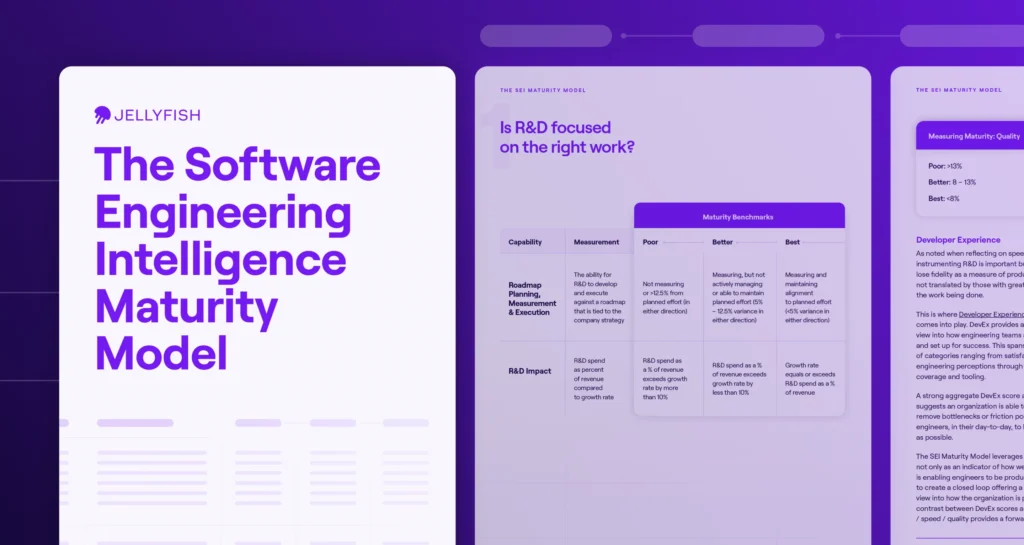In this article
Let’s face it, whether you’re new to measuring engineering productivity or a veteran – figuring out how to measure engineering productivity is daunting. That’s where Jellyfish comes in. We worked with over 500 software companies, 11,000 development teams, and 100,000 engineers to develop a measurement framework you can implement in your own org.
1. Align on team outcomes
1. Align on team outcomes
Focus on outcomes not the measurement itself. Ultimately, every team wants to deliver value to the business – efficiently and sustainably. Measurements are just a way to assess how a team is performing against that outcome.
Core outcomes include:
- Focusing on the right things
- Delivering efficiently
- Delivering quality
- Team is healthy and motivated
2. Start measuring and collecting data
2. Start measuring and collecting data
Get started quickly with a combination of both system data and survey data to provide a balanced perspective.
System data focuses on measures derived from the tools your team uses. We recommend baselining each team with the following five system metrics:
- Team allocation
- Epic throughput
- PRs merged
- PR cycle time
- Defects opened
DevEx surveys are a great way to get a quick pulse on the team and provide additional context to the system metrics you collect. Get started by surveying your team on:
- Context switching
- Clear direction
- Team processes
- Codebase health
- Satisfaction and well-being
- Learning and growth
Each of these measures helps inform progress against the four key outcomes and the average benchmarks provide context on where to focus:

How does AI factor into this?
Your AI measurement strategy should largely align with your existing KPIs, serving as an additional layer for your standard speed,quality, and developer experience metrics. We offer an AI Impact framework specifically aimed at helping organizations navigate quantifying the impact of AI.
3. Discuss the framework with your team and brainstorm an action plan
3. Discuss the framework with your team and brainstorm an action plan
Have an open and objective discussion with the team on productivity. Incorporate these measures into team rituals, such as planning and retros to discuss possible issues and root causes. Each month or quarter, choose one to three focus areas and brainstorm what actions the team would like to take. Document the priorities and actions to make them public to the team, assigning owners where necessary. Set appropriate goals for the team in Jellyfish so you can automatically track progress.
Monitor your priority metrics alongside Jellyfish’s Team Pulse feature to track on-time delivery during planning meetings and use Metrics Explorer to discuss cycle times and throughput as a team.
4. Follow up, reflect, iterate
4. Follow up, reflect, iterate
Don’t fall victim to losing steam after building great momentum. Include these measures in retros or establish a monthly cadence for following-up on progress. Follow through is a critical component for engineers to trust their leadership. Having that conversation only to never talk about it again undermines trust that something will be done.
Consistently refine and iterate
Consistently refine and iterate
This is just the starting point. You’ll have to consistently refine and iterate to ensure your team is successfully executing on core outcomes. As the team gets more comfortable with outcomes and measurement, you should further hone the measurement strategy.

The Software Engineering Intelligence Maturity Model
Ready to measure and maximize your R&D productivity?
About the author

Ryan Servais is a Product Manager at Jellyfish.
About the author

Tricia is a Senior Product Manager at Jellyfish.




